Hazard Perception Types
Introduction
 There are 13 common hazard types or categories that you need to look out for while on the test or indeed while on the road for real. These are shown below. To find out more about each hazard type click on the type and further advice will appear.
There are 13 common hazard types or categories that you need to look out for while on the test or indeed while on the road for real. These are shown below. To find out more about each hazard type click on the type and further advice will appear.
In the previous section about the test you will have started to appreciate the difference between a 'potential hazard' and a 'developing hazard'. This section covers this in more detaill. The two can be the same but occasionally you will see a potential hazard that has not yet started to become a developing hazard. This is why it is possible to click too early on certain clips and score zero. This is also why the official introduction video to the test tells you to click each time you see a change. For example, if someone ahead indicates to turn left or right it doesn’t necessarily mean it is the start of a developing hazard it all depends upon whether the proposed manoeuvre will cause you to slow down or change position. At the point this becomes likely the developing hazard will start. Never-the-less you should still click if the vehicle ahead indicates or brakes even if you are unsure whether a hazard has started to develop or not but remember to continue to click as further clues or changes occur.
The reason why most experts recommend you click up to 3 times as the hazard develops is to overcome the potential problem of clicking too early and thus missing the start of the score window. The following notes will help you to understand why this can occur on certain hazard test types. The start point of most of the developing hazards shown on the actual test are quite obvious and it is only the odd developing hazard where this may be a problem. You needn't worry about clicking to early just make sure you continue to click as more clues or changes materialise. In this way you will be certain of scoring on every clip.
1 Zebra crossings & traffic controllers
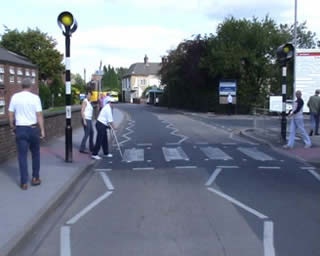
The first type of hazard commonly featured on the Hazard Perception Test is triggered when:
- A pedestrian approaches a zebra crossing with the intention of moving onto the crossing or;
- A school crossing patrol officer moves to the edge of the road and shows a stop for children sign or;
- An authorised traffic controller gives a signal to stop.
There is some advice given in the Highway Code about the above situations:
171. Zebra Crossings. As you approach a Zebra crossing:
- Look out for people waiting to cross and be ready to slow down or stop to let them cross.
- You must give way when someone has moved onto a crossing.
- Allow more time for stopping on wet or icy roads.
- Do not wave people across; this could be dangerous if another vehicle is approaching.
- Be aware of pedestrians approaching from the side of the crossing.
184. Near Schools. Drive slowly and be particularly aware of young cyclists and pedestrians. In some places, there may be a flashing amber signal below the "School" warning sign which tells you that there may be children crossing the road ahead. Drive very slowly until you are clear of the area.
186. You MUST stop when school crossing patrol shows a "Stop" for children sign."
So as soon as you see a zebra crossing, school crossing patrol or authorised traffic controller ahead get ready to click your mouse button as soon as the potential hazard starts to develop. In the real world you would take action as soon as you recognise the potential hazard even if it was just to check your mirrors to see what was behind.
2 Pedestrians: Children & young adults

Children are often more interested in the game they are playing than road safety. Hence, whenever you see a child up ahead remember they may not be aware of your presence and may step or cycle into the road. If a child runs across the road they may well be followed by another child. If a ball or Frisbee appears on the road it may well be followed by a child.
Teenagers and young adults can be, and often are, fearless when it comes to crossing the road. They sometimes believe they are invincible and accidents don't happen to them. This attitude toward risk can lead to serious problems so don't be surprised if they dash across the road at the very last minute or indeed stroll across the road as if tomorrow will do. So if you see teenagers or youths, particularly in a gang, look to see how they are behaving - are they in responsible mode?
There is some advice given in the Highway Code about the vulnerable pedestrians such as children:
"183. Particularly vulnerable pedestrians. These include
- Children and elderly pedestrians who may not be able to judge your speed and could step into the road in front of you. At 40 mph your vehicle will probably kill any pedestrians it hits. At 20 mph there is only a 1 in 20 chance of the pedestrian being killed. So kill your speed.
- Elderly pedestrians who may need more time to cross the road. Be patient and allow them to cross in their own time. Do not hurry them by revving your engine or edging forward
- Blind and partially sighted people who may be carrying a white cane (white with a red band for deaf and blind people) or using a guide dog
- People with disabilities. Those with hearing problems may not be aware of your vehicle approaching. Those with walking difficulties require more time."
The above Highway Code advice equally applies to our next hazard category. So if you see a child or any signs that children might be about get ready to click the mouse button. Similarly, if you see any youths ahead make sure you are ready to act.
3 Pedestrians: Elderly & infirm
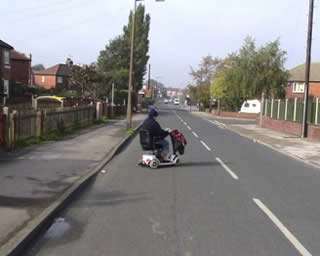
It is not uncommon for the elderly or infirm to need more time to cross the road or enter or exit a vehicle. An elderly person may also suffer from a number of age related illnesses that prevent them from seeing, hearing or comprehending how fast traffic is approaching. They may simply underestimate how quickly they can move. Therefore watch out for the elderly or infirm as they cross the road or enter or exit vehicles.
As the population becomes more elderly it is also becoming increasingly more common to see small electric vehicles for the disabled on the road. The slow speeds of such vehicles coupled with the above potential problems of the drivers require you to give them special attention. See the previous category for Highway Code advice. Therefore, look well ahead for old people, people with walking sticks or aids, people in wheel chairs or electrical disability vehicles.
4 Pedestrians: Adults

Even able-bodied responsible adults sometimes end up on the road when they shouldn't. Unfortunately, their attention may be distracted or they may be so involved with another task they forget the dangers of stepping onto the road. Alternatively, they may be under the influence of drink or drugs.
Therefore watch out for adults washing, repairing, loading or unloading vehicles at the side of the road. Indeed watch out for anyone who is undertaking some task or job near the side of the road. Watch out for pedestrians crossing between parked cars; they may not have seen you. Basically, watch out for any pedestrians who do not seem to have their full attention on the road they are crossing or stepping onto.
5 Cyclists & motorcyclists
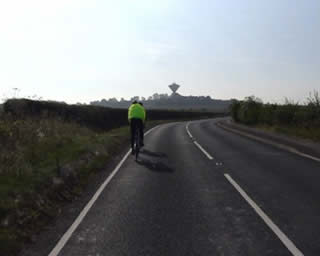
Cyclists are very vulnerable, not easy to see, travel at relatively low speeds and need space to wobble. Drivers overtaking cyclists often do not give them sufficient room or appreciate how quickly they will be upon them. This leads to a number of hazards involving the overtaking of cyclists particularly where the road ahead becomes narrow and does not permit you to give adequate clearance while overtaking or where your view of the road ahead is impeded. Because cyclists are usually travelling so much slower than normal traffic you do need to be prepared to slow down in plenty of time.
Because cyclists cannot pick up speed quickly you may also need to slow down for them when they emerge from side roads, cycle lanes or the footpath. For the same reason cyclists can become a hazard when they need to move out to avoid objects in the road, overtake stationary vehicles or turn right. Often such manoeuvres are preceded by a glance over the right shoulder, this is behaviour you should be particularly sensitive too. Whenever, you see a cyclist ahead put yourself in their position and think what might happen next.
Motorcyclists do not usually suffer from poor acceleration or low speed but they are still very vulnerable and difficult to see. As a result vehicles may emerge into their path and cause the motorcyclist to swerve onto the opposite side of the road. Motorcyclists turning left or right might not be noticed with the result that following vehicles may brake harshly as their drivers realise they cannot safely pass the turning motorcyclist ahead.
Therefore whenever you see a cyclist or motorcyclist ahead consider what might happen next and be prepared to click as soon as the problem starts to develop or it becomes apparent that a potential problem will materialise.
6 Horse riders & other animals
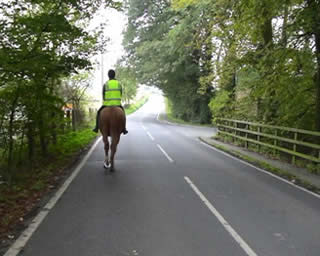
Horse riders like cyclists travel at relatively slow speeds and following or approaching traffic can be upon them far more quickly than the driver appreciates. This can result is harsh braking and/or vehicles overtaking horse riders when it is not safe to do so. Just like cyclists you need to give horse riders plenty of room when you overtake them. You also need to appreciate that the horse might be startled as you overtake particularly if you are travelling too quickly or too close. This could result in the rider being thrown from the horse and/or the horse bolting into the path of any overtaking or approaching vehicle.
Therefore you must drive slowly when approaching or overtaking a horse rider irrespective of the room you might have. Any sudden noise would also cause the horse to become unsettled so avoid the use of the horn and do not rev the engine.
Horse riders are even slower at picking up speed than cyclists and may find it very difficult to stop once committed to emerging from a side road therefore always be prepared to slow down if you see a horse rider emerging from either the left or the right ahead.
On roundabouts horse riders always keep to the left even if they are turning right. A horse rider would normally use a right hand signal to show he or she was not about to take the next exit.
This is what the Highway Code states about horse riders:
"191. Horse riders. Be particularly careful of horse riders, especially when overtaking. Always pass wide and slow. Horse riders are often children, so take extra care and remember riders may ride in double file when escorting a young or inexperienced horse rider. Look out for horse riders' signals and heed a request to slow down or stop. Treat all horses as a potential hazard and take great care."
One of the reasons you should approach bends or narrow country roads with care and at low speed is due to the fact that a horse rider might just be around the corner.
Any animals ahead represent a potential hazard particularly if they are not under the control of their owner. Slow down and be prepared to stop, if safe to do so, when it becomes apparent that any animals ahead might or has ventured onto the road. If a road is blocked by a herd of animals, stop and switch off your engine until they have left the road. Watch out for animals on unfenced country roads.
Remember when passing animals, drive slowly, give them plenty of room, avoid any sudden noise and be ready to stop. As soon as you see an animal ahead on the road click the mouse button as it will usually always represent a hazard to you.
7 Vehicles: moving off or pulling up
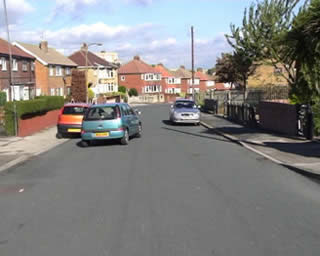
Vehicles ahead moving off or pulling up may represent a potential hazard depending upon whether they may cause you to slow down, overtake or stop.
The driver of a vehicle moving off ahead might not have seen you or may have misjudged your speed causing you to have to slow down, stop or overtake. A vehicle moving off from behind parked vehicles may also need to swing out into the road impeding progress of both following and approaching traffic. Therefore watch for any vehicles ahead moving off and assess whether it may cause you a problem. Usually an indicator signal warns you of this developing hazard ahead. However, sometimes the signal may not be applied or may have automatically turned off as they commence the manoeuvre, therefore you should also watch out for vehicles edging out from behind a row of vehicles ahead. Alternatively, you might see the driver or passenger entering the vehicle just prior to moving off or a person waving goodbye.
The problem with vehicles pulling up is usually associated with those drivers who are looking for a suitable parking place and may pull up and signal at the very last minute. Early signs of this are vehicles which are altering speed in an erratic manner or moving road position for no apparent reason. Keep well back from drivers exhibiting such behaviour. Another problem you should be aware of with vehicles pulling up is the tendency for either the driver or the passenger to open the door without looking behind which may cause you to slow down, change position or stop. So if a vehicle ahead pulls up, watch to see if the door starts to open.
Buses, coaches and trams particularly have difficulty moving off and stopping because of their size and weight. As well as watching for indicator signals or brake lights when a bus starts to pull up the movement of passengers in the vehicle or potential passengers at the road side may also provide an early clue. For example, you may see a passenger stand up on the bus as it approaches a bus stop or you may see people at the bus stop move towards the road edge and hold out their hand. If a vehicle is pulling up determine if it can easily fit into the space it proposes to use. If not, will it cause you a problem? You may not realise it but you are required to give priority to buses, coaches and trams especially when they are moving off. See Highway Code rule 198 below:
"198. Buses, coaches and trams. Give priority to these vehicles when you can do so safely, especially when they signal to pull away from stops. Look out for people getting off a bus or tram and crossing the road."
8 Vehicles: meeting
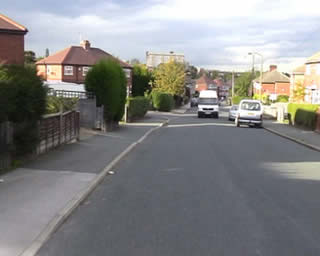
Vehicles meeting are one of the most common potential hazards you are likely to come across particularly if you live in a busy suburban area where parking is at a premium. This hazard appears whenever the road narrows so that only one vehicle can proceed at a time or where two vehicles can proceed but only very slowly. Single track country roads also present a similar problem although you are less likely to meet volumes of traffic. Sometimes approaching large vehicles can cause this situation simply because of their width.
Deliberate road narrowing is also used as a traffic calming measure. Where it is a physical feature road signs usually exist to warn you of this hazard and who, if anyone, has priority.
If the road narrows due to an obstruction on your side of the road you are required to give priority to approaching traffic unless road signs state otherwise or it is clear that the opposing vehicle wants you to proceed first.
If, however, stationary vehicles are parked on both sides of the road no one has priority. Courtesy and common sense play an important role in this circumstance. Normally, the vehicle that is most likely to reach the obstruction first would assume priority and the opposing vehicle would give way. However, you also need to consider whether taking priority would stop the potential flow of traffic depending upon what was following the opposing vehicle and whether any refuges ahead exist that you could use to prevent this.
Even if the opposing vehicles do not have priority over you it may be necessary for you to give them priority to prevent a jam in the traffic flow depending upon the pattern of parked vehicles ahead and the traffic flow in either direction. People who live in the suburbs of major cities like London will in particular appreciate this problem.
Similarly, you should be prepared to give priority to larger vehicles that need more space and time to slow down or have more difficulty moving off on steep gradients.
So how do you spot this potential hazard? Well firstly you need to recognise that the road ahead narrows and that progress might be impeded depending upon any approaching traffic. Then you need to assess your progress and that of any approaching traffic. This is where your ability to judge speed and distance are particularly important. From this you will need to determine if you should reduce speed and/or road position. If your view of approaching traffic is not clear due to a bend in the road ahead or some other obstruction you need to assess whether your current speed and position would give you time to safely react to any approaching traffic that might subsequently appear. If not you need to reduce speed and/or road position now rather than gamble on no oncoming traffic appearing at the last minute.
So if you can see that the road ahead is or will become narrower and there is approaching traffic that is likely to impede your progress you will need to click the mouse button as the potential hazard is now developing.
9 Vehicles: emerging
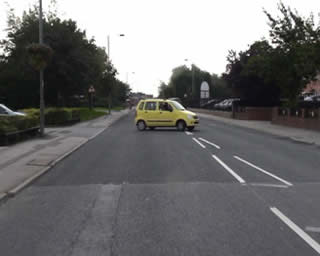
We have already covered how cyclists and horse riders can particularly present a problem when emerging. However, in this category we will focus on the other vehicle types that might cause a hazard when emerging.
Slow moving or long vehicles can often present a hazard as they emerge from a side road. Sometimes it is difficult for the driver of the emerging vehicle to see any approaching vehicles (particularly motorcyclists) or properly assess their speed with the result that the vehicle emerges into the road when it is not safe to do so. You could argue that this is the fault of the emerging driver; however, this is little consolation if you are involved in an accident.
Experienced drivers appreciate how difficult it can sometimes be to emerge absolutely safely with zero risk. Consequently, an experienced driver would be assessing the road conditions and the junctions ahead for the tell tail signs where emerging drivers might face such problems. This is why you need to be considerate when driving, to put yourself in the position of others and remember we can all make mistakes and occasionally do. Hence the reasons for the following Highway Code rule:
125. Be considerate. Be careful of and considerate towards other road users. You should:
- Try to be understanding if other drivers cause problems; they may be inexperienced or not know the area well
- Be patient; remember that anyone can make a mistake.
- Not allow yourself to become agitated or involved if someone is behaving badly on the road. This will only make the situation worse. Pull over, calm down and, when you feel relaxed, continue your journey
- Slow down and hold back if a vehicle pulls out into your path at a junction. Allow it to get clear. Do not over-react by driving too close behind it."
So how do you recognise this potential hazard? Firstly, you may have a warning sign of a junction ahead, if so, this will be for good reason. Perhaps a number of accidents have occurred at that spot or perhaps a bend, dip, hill or other physical feature can make emerging more difficult. While this sign provides an advance warning the hazard does not develop until you see a vehicle emerging or about to emerge, this is the point at which you need to click. However, in the real world you would start your hazard drill as soon as you recognise the potential hazard.
For example, you may be approaching a side road on a busy road with lots of parked vehicles that obscure the emerging driver's view of you. The road may be so busy that drivers in the side road may also feel under pressure to emerge. This combination of circumstances makes it quite probable that a vehicle will emerge when it shouldn't. You should recognise this possibility and be on the look out for the front of vehicles edging out of the side road onto the main road ahead. Sometimes you can see the top of the vehicle as it is driven down the side road towards the main road or you may see its wheels under a parked vehicle or you may get a glimpse of the emerging vehicle between a gap in the hedge or row of parked vehicles. As soon as you see the clues click the mouse button. The Highway Code gives advice about driving in busy built up areas:
130. Narrow residential streets. You should drive slowly and carefully on streets where there are likely to be pedestrians, cyclists and parked cars. In some areas a 20 mph maximum speed limit may be in force. Look out for:
- Vehicles emerging from junctions
- Vehicles moving off
- Car doors opening
- Pedestrians
- Children running out from between parked cars
- Cyclists and motorcyclists
10 Vehicles: turning left or right
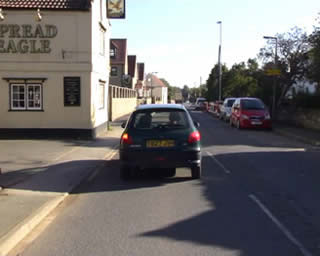
Any vehicle ahead that may be reducing speed, changing position or turning represents a potential hazard and should command your attention.
Provided drivers ahead have given adequate warning of their intention to turn left or right and provided nothing impedes them from completing the task this rarely results in a developing hazard. Hence, when a vehicle ahead gives a signal to turn left or right it is not necessarily the start of a developing hazard.
However, if it was immediately apparent that the turning vehicle would not be able to complete the manoeuvre and as a consequence would cause you to slow down or possibly stop the signal does signify the start of the developing hazard. If however, this was not the case the developing hazard would not start until it became more apparent that the vehicle could not complete the manoeuvre and was therefore a real hazard to you. It would be at this point that a click of the mouse button would result in a score. If you like you can click when you see the vehicle signal and then click again when it is apparent that the turning vehicle will become a hazard.
An experienced driver would immediately try to determine where any signalling vehicle ahead was turning or indeed parking and whether it might have difficulty completing the manoeuvre. For example, people crossing the entrance of the side road or opening into which the vehicle was turning might hold up the turning vehicle and so cause a hazard. A narrow side road or one at an acute angle may cause similar problems as might the appearance of an emerging vehicle.
In addition when a vehicle is turning right you would not only look at the entrance to the side road you would also look at the oncoming traffic to see if this would prevent the driver from turning. From this you would realise whether you needed to slow down, stop and/or change position. The hazard caused is not unlike the meet situations covered earlier as the turning vehicle becomes an obstruction.
11 Vehicles: reversing & U-turns
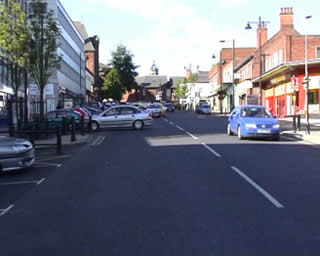
Vehicles ahead reversing into the main road from a side-road, a drive-way or a parking space or parking bay may cause you to stop, slow down or overtake and as such are another common hazard you need to look out for.
When a driver is reversing out, their view and ability to move away quickly is significantly reduced from driving out forwards. Consequently, if you see a car reversing ahead it is quite possible they may not have seen you or misjudged the time it will take them to emerge and drive away. Hence, reversing vehicles often are a sign of the start of a developing hazard ahead. The Highway Code advises the following in this regard:
"177.Do not reverse from a side road into a main road. When using a driveway, reverse in and drive out if you can."
In shopping areas with parked cars along the street you also need to be aware of drivers stopping just past a potential parking space with the intention of doing a reverse park.
Vehicles who try to do U-turns often misjudge the turning circle of their vehicle and the width of the road with the result that they need to stop and reverse to complete the task. As a consequence they temporarily block the road and may cause you to stop. So if you see a vehicle ahead who swings out to the left or the right, particularly at the entrance of a side road or a mini-roundabout, they may well be attempting this manoeuvre and represent a developing hazard. So as soon as the vehicle ahead starts to take an unexpected path or position click the mouse button as it may well be trying a U-turn or some other unusual manoeuvre.
12 Vehicles: larger Vehicles
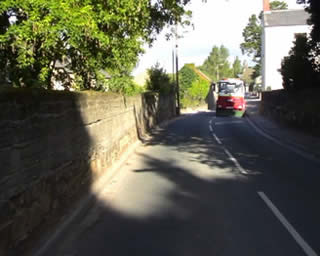
Large vehicles can present a number of potential hazards due to their size and weight when manoeuvring. When moving off or emerging they are usually much slower than smaller vehicles and therefore need more time to emerge. Emerging vehicles may also need to swing onto the other side of the road even when emerging to the left from a junction due to their length, the shape of the junction or the circumstances that prevail at the time.
On narrow roads or at certain bends the width and/or length of a large vehicle may cause the vehicle to move onto the opposite side of the road causing oncoming vehicles to slow down, stop and/or move position. Therefore, you need to recognise when an approaching large vehicle may impede your progress due to the layout of the road ahead and the vehicles physical dimensions.
Large vehicles turning left or right may also take up unusual road positions when negotiating a junction or roundabout. So try to put yourself in the shoes of the driver of the large vehicle and think about the room they need and the road position and paths they may have to take when turning. You then plan your actions accordingly. Remember this acronym OAP, observe - anticipate - plan. If you observe, anticipate and plan well while driving you may well live to become an OAP. As soon as the potential problem you have recognised starts to develop (i.e. shows signs of doing what you have anticipated) click the mouse button.
Often large vehicles need to negotiate narrow openings and side roads when delivering goods to suppliers. As a consequence they may need to move backwards and forwards across the main road to achieve this. So be patient and be grateful it is not you who has to reverse a ten tonne articulated lorry down a narrow side road. If a large vehicle stops ahead for no apparent reason in a slightly odd position with hazard warning lights they may well be about to start such a manoeuvre.
13 Vehicles: flashing lights
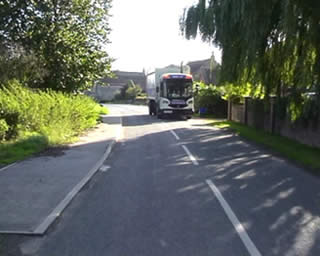
Slow moving utility, works and agricultural vehicles have flashing amber lights to warn you that they present a hazard. The vehicles may simply be driving along or undertaking some task such as gritting the road, cutting grass or hedges, collecting refuse etc. When stationary expect to see work-men round about these vehicles. Amber flashing lights mean hazard so as soon as you see the lights click the mouse button and click again as soon as you recognise the problem it will cause to you. This is the advice given by the Highway Code on vehicles with amber flashing lights:
"200. Vehicles with flashing amber lights. These warn of a slow-moving vehicle (such as a road gritter or recovery vehicle) or a vehicle which has broken down, so approach with caution."
Emergency vehicles use flashing blue, red or green lights, headlights and/or sirens. Consider the route of the emergency vehicle and take appropriate action to let it pass. If necessary, pull to the side of the road and stop, but do not endanger other road users. If it is necessary for you to slow down, stop or change position it is a developing hazard. Again as with the amber flashing lights you click the mouse as soon as you see them and again when you recognise the problem it will cause you.